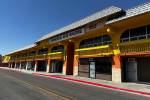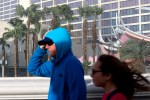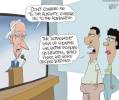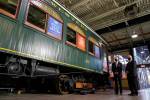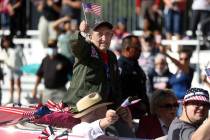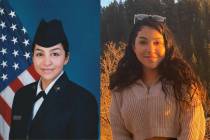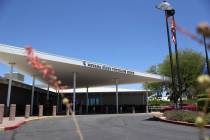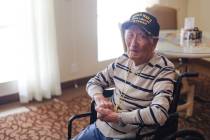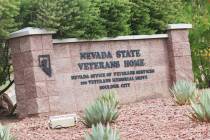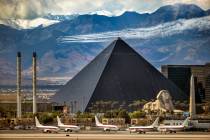Dangers lurk during patrols

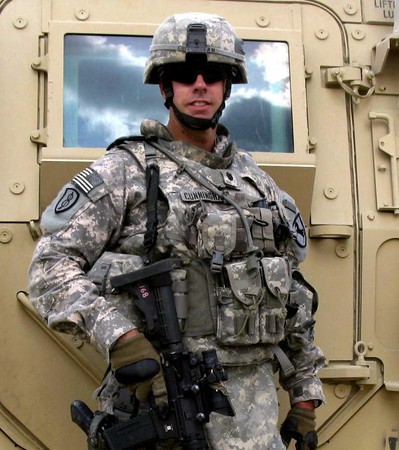
Editor’s note: This is the third in a collection of periodic essays from Afghanistan by Lt. Col. Scott Cunningham, commander of the 1st Squadron, 221st Cavalry, the largest overseas deployment of Nevada National Guard troops.
Nov. 24
They slosh across creeks and stalk through cornfields, hunting down enemy combatants on the outskirts of Afghan villages.
Every day since arriving five months ago, Nevada Army National Guard soldiers on foot and on the road have been performing a task they’ve spent years training for: patrolling.
It’s one of the most common missions conducted in this mountainous Central Asia nation by the troopers of 1st Squadron, 221st Cavalry. Many civilians have heard the words “on patrol,” but it’s important to understand what that means to the soldiers deployed here.
Patrols include quick response to enemy threats, reconnaissance, going into the local areas and searching for the enemy, protecting the people from enemy attack or simply showing coalition force presence.
All soldiers assigned to the Wildhorse Squadron participate. “Everyone Fights” is an informal motto that we have in regards to not only our cavalry scouts, but also our staff soldiers, mechanics, cooks, medics, and all the senior leaders.
Everyone is expected to contribute to combat missions such as patrols. Also, the mission will often be conducted with Afghan army or police alongside as partners. It’s their war, and it’s important to always be working with them. The Afghan army in particular is competent, and the soldiers are brave and willing to fight.
Preparation starts hours before actually leaving the base. The patrol leader receives the operations order with the mission and goals of the patrol from the squadron operations officer. After determining how he will conduct the mission, he will assemble the soldiers and issue his patrol order. This will cover mission objectives. To save time and increase the simplicity of the mission, battle drills are often used. Finally, the patrol inspects all equipment and mounts up in the vehicles staged near the gates.
The vehicles depart the base and head “outside the wire.” That’s our term for any mission being conducted outside of the secure confines of the base. At this point, the patrol is fully suited up, armed, armored and ready for anything. Weapons are charged, radio checks are made, and a final intelligence summary is received from the Tactical Operations Center. Normally, the patrol will move mounted to its patrol area, the turret gunners scanning, the infantrymen in the back looking out the windows as best they can to detect enemy attack.
The standard vehicles are the trusty HMMWV (Hummer) and the larger MRAP. Both have machine guns mounted in turrets on the roof, decent mobility, excellent protection and room for troops inside. On the downside, they are limited to the larger roads and trails. With some of the roads suitable only for foot or donkey traffic, many places cannot be driven. At that point, we either move by helicopter or walk.
The main threat here is IEDs, which target the vehicles. In a high-threat area, the soldiers will almost always dismount the armored vehicles and move forward on foot. In addition to making the soldiers far less vulnerable, it vastly increases their situational awareness by allowing them to look and listen, as well as the opportunity to engage if contact is made. Also, the dismounts are critical in spotting and engaging the IED triggermen, who normally hide 300 to 500 meters off to the sides of the road, waiting for a vehicle to target.
Moving dismounted is often safer, but it can be a lot more unpleasant. A soldier on patrol wears a huge amount of equipment. With body armor, weapons, water, ammunition, communications gear optics and other equipment, the basic load can approach 85 pounds. If it is a longer-duration patrol, air assault mission or a deep dismounted combat patrol, you can add in a rucksack, extra batteries, water and food, and additional weapons and mission specific equipment (such as mortars) that often push the soldier load up to a crushing 150 pounds. Combine that with operating in a mountainous area and 120 degree summer heat, and you have an idea of how miserable it can be to operate.
Back injuries and twisted ankles are common. Also, water use can is critical when operating dismounted. In the summer, you can sweat up to two quarts an hour. It’s tiring, and heat casualties can rapidly occur unless the soldiers and leaders are extremely disciplined about water consumption and hydration.
Patrolling can be mentally stressful as well. The threat of enemy contact is always present. While moving mounted you are constantly on the lookout for disturbances in the road, trigger wires, ambushes, potential IED triggermen or anything else out of place. When dismounted, you look for all of the above, but have to take account of suicide bombers, snipers and any other threat.
You are constantly scanning, sensing the body language, the reaction of the local nationals, and overall mood of the population. Profiling is a skill that you develop quickly, and you learn to rely on that sixth sense that so often is ignored in civilian life.
The enemy in Afghanistan is elusive. They will rarely attack unless they have absolute superiority. Because of that, we usually maneuver with enough soldiers and firepower to defeat any potential threat we may encounter. Getting cut off by a superior force is a recipe for disaster. A TIC, or “Troops in Contact” is unlikely in any given patrol, but essentially inevitable over the course of an entire deployment. It can be either an IED, long-distance harassing fire or a close-up ambush. Depending on the enemy tactic, the maneuver unit will immediately attempt to pin the enemy down, and then use artillery, helicopters, or aircraft weapons on him, or flank them with maneuver forces.
The enemy has the tendency to attack from long range and then run away, often into villages, where our rules of engagement prevent us from effectively engaging him, or into the mountains where the weight of our gear prevents rapid pursuit.
In late summer, patrols around some polling places engaged in occasional gunbattles to quell militants bent on disrupting elections.
After completing a primary mission, it’s time to “RTB,” or return to base. As the patrol rolls in the gate, weapons are cleared, all equipment is accounted for, and the soldiers can finally let down their guard. Still, the work is not done, as all vehicles must be fueled, the intel officer debriefed, ammunition restocked, maintenance problems repaired, and all made ready for the next mission.
The length and detail of debriefings vary with each mission. Topics could include whether contact was made with someone, a village was patrolled, a road was secured, meetings were kept with town leaders and searches were conducted for IEDs.
Day in and day out, these missions occur. Patrols of this nature are the backbone and foundation of counterinsurgency operations. Every day, without pause for weekend, holiday, or weather, patrols are being run by the troopers of the Wildhorse Squadron.
It’s all part of the overall goal of making Afghanistan a secure, peaceful, and eventually prosperous member of the world community.




